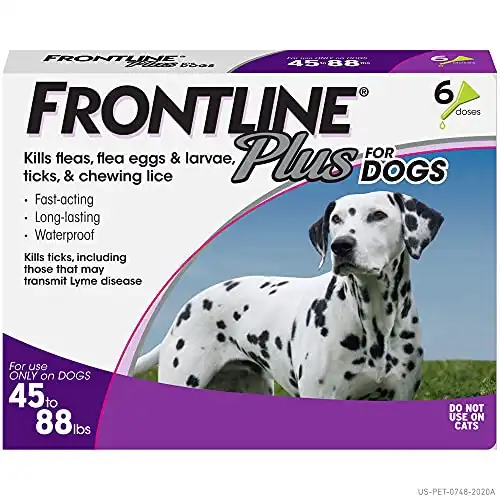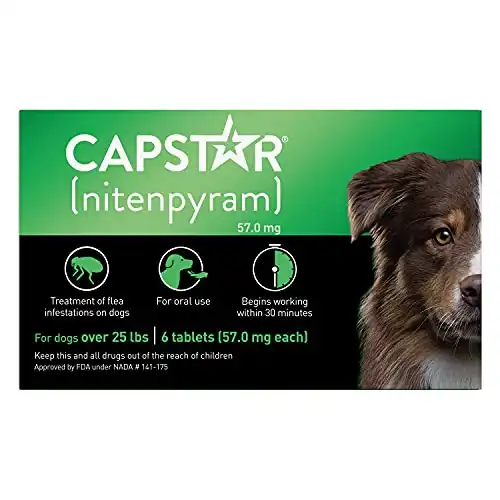Is your dog itching or scratching themselves? They could have fleas, causing them to itch. These pesky little parasites can sometimes be very hard to find and sometimes very hard to get rid of. These are some signs that your dog may have fleas and things that you can do to help them get rid of these fleas.
The most common signs that a dog has fleas include the visible presence of fleas or flea poop or if the dog is itching, losing hair, or has red bumps. Because fleas can carry other diseases, it’s important to address them quickly.
If your dog has fleas, you will want to start treating them and their environment for fleas. Some fleas can carry diseases that your dog and cat can catch, making them very sick, so it’s important to recognize and treat them quickly!
5 Signs That Your Dog Has Fleas
Below are the 5 quickest ways to tell if your dog has fleas. If you notice any of these signs, it is best to start treating them for a flea infestation.
1. You Can See the fleas!
The most obvious way to tell if your dog has fleas is to find a flea on them. Sometimes this can be hard to do, depending on the type of fur that the dog has.
For example, short-haired dogs like Great Danes are much easier than longer-haired breeds such as Golden Retrievers.
You can use a flea comb to brush through your dog fur to help you locate these fleas. One great place to start to look is right over their hip and back towards the base of their tail. This is a very common spot for fleas to live on your dog.
2. You see flea dirt
While fleas can sometimes be hard to find, you can usually find a small amount of flea dirt. Flea dirt is actually poop from the flea. This is digested blood!
If you are having a hard time figuring out if this is flea dirt or something else, take a damp white paper towel and put the flea dirt on there. Flea dirt will start to turn the paper towel a dark red where the flea dirt is.
Since this is digested blood, it will look just like dried blood on a paper towel.
3. Your Dog is itching
The number one sign of a flea infection is your dog is itching. Most dogs are very allergic to flea saliva.
If these fleas get on your dog, not only will their presence cause your dog to itch, but once they bite your dog, their saliva will cause your dog to itch.
Most dogs will itch and chew where these fleas are located, trying to get them off of them.
During this time, your dog may accidentally eat a flea. Fleas carry tapeworms which, when your dog eats them, will pass these worms on to your dog.
If you notice fleas in your dog, also be on the lookout for tapeworms in their stool. This will look like small grains of rice.
4. Your Dog is losing their hair
If your dog has fleas, they will be itching, which can cause them to lose their hair. Hair loss is commonly seen on the back of your dog or their sides. These are areas that your dog can easily reach.
If you do not see hair loss, this could be something else, such as allergies or mites causing your dog to lose hair that your vet would need to help diagnose.
5. Your Dog has red bumps
Many times, these flea bites will leave your dog with red bumps. You will notice these on their back and especially on their abdomen and legs. If you see these little bumps, it is best to start looking for fleas.
These bumps can turn into small, infected areas and look like pimples. If your dog has a lot of pimple-looking bumps, they will need to see your vet for a prescription antibiotic.
Another thing that you can do to help get rid of these pimple-looking bumps is to give your dog a bath in oatmeal or antibacterial shampoo.

What To Do If Your Dog Has Fleas
If you just notice that your dog has fleas, there are a few things that you can do to help get rid of these fleas. Things to do at home to get rid of fleas:
1. Give your Dog a Flea Bath
If you notice fleas on your dog, the fastest way to get rid of them is with a bath. This will wash off any fleas that are currently on your dog.
The bad thing is that this just treats the fleas that are on your dog at the time of the bath. As soon as they go back outside, they can get more fleas on them, causing them to have more issues.
2. Wash all bedding and blankets
If you see fleas on your dog, most likely, they are also living in your dog’s environment. It is best to wash all blankets and bedding. This will help remove any live fleas and flea eggs.
Wash their beds in very warm water and dry them on high to help kill any fleas that are on their bedding.
3. Vacuum carpet, couches, and other areas
Since fleas live in your dog’s environment, it is best to vacuum the carpet, couches, and floor around where your dog stays. It is best to do this every few days until you get the flea infestation under control.
Fleas will constantly be hatching, so making sure that you vacuum often will help decrease the flea population in your house. Make sure to empty the vacuum after each cleaning to prevent them from escaping from the vacuum back into the house.
4. Treat your backyard
If your dog spends a lot of time in the backyard playing, it would be best to have your backyard treated for fleas.
You can call a pest control company to do this, or there are some products that you can pick up at your local home and garden store to help with
5. Give your dog flea medication
There are many over-the-counter products that you can use to help get rid of fleas on your dog. Advantage and Frontline are the best two over-the-counter medications.
These are topical medications that last for about 1 month. Capstar is another great medication that you can get over the counter. This medication is a pill and only lasts for 24 hours.
-
Buy on Amazon Buy on Chewy
This treatment is specifically formulated to kill all life stages of fleas on contact with no painful biting required. With three-way protection that kills the eggs, larvae, and adults, it breaks the flea life cycle to help prevent re-infestation.
-
Buy on Amazon Buy on Chewy
It’s formulated with two active ingredients to help disrupt the flea life cycle and inhibit future infestations. Plus, it’s designed to be waterproof after 24 hours, fast-acting, and long-lasting!
-
Buy on Amazon Buy on Chewy
These tablets offer swift relief from adult fleas and can be used whenever you find fleas on your cat or dog. Designed as a small tablet, Capstar won’t rub or wash off, which means it won't leave dangerous pesticide residue on your pet!
6. See your vet
While some over-the-counter flea medications may not get rid of your flea infestation, your vet can prescribe flea and tick prevention for your dog.
Many times, these are chewable pills that your dog will take each month.
Common medications for flea and tick prevention are NexGuard or Bracevto. These two medications will require a prescription from your vet and are more effective than any over-the-counter flea medication.
Why do I need to treat my dog for fleas?
While these parasites can cause your dog to itch, they can also carry diseases that can be transmitted to your dog and even you.
These are a few diseases that fleas can cause:
Anemia
Fleas can suck blood from your dog. They can cause them to become anemic. This really is only a problem in very small dogs or sick dogs.
Very small puppies can even die from an overabundance of fleas draining their blood supply.
Tapeworms
Most fleas carry tapeworms. If your dog eats a flea that contains a tapeworm, these tapeworms can be transmitted to your dog. Tapeworms can compete with your dog for food and cause them to be very skinned.
You can easily tell if your dog has tapeworms as you can see these parasites in their poop. Tapeworms look like small grains of rice and will commonly be found in the fecal material of a dog that has a large number of fleas.
Other diseases that fleas carry
There are other diseases that fleas carry that are more commonly seen in cats and people. These diseases include:
- Cat Scratch Disease – Bartonella henselae
- Mycoplasma haemofelis
- Murine Typhus
Most flea medications also will help protect your dog from ticks. There are many diseases that ticks can carry that can cause your dog to be very sick. Giving them year-round flea and tick prevention will help keep them healthy and happy for many years!
Final Thoughts on Fleas
Fleas can be very frustrating for both you and your dog. If you are noticing any of these signs in your dog, it would be best that they see your vet. Your vet can prescribe medications to help get rid of the fleas.
If you do have a flea infestation, it is best to treat all animals, fully clean the house and bedding and treat the backyard for parasites. This will help your dog from getting reinfected with these parasites.



